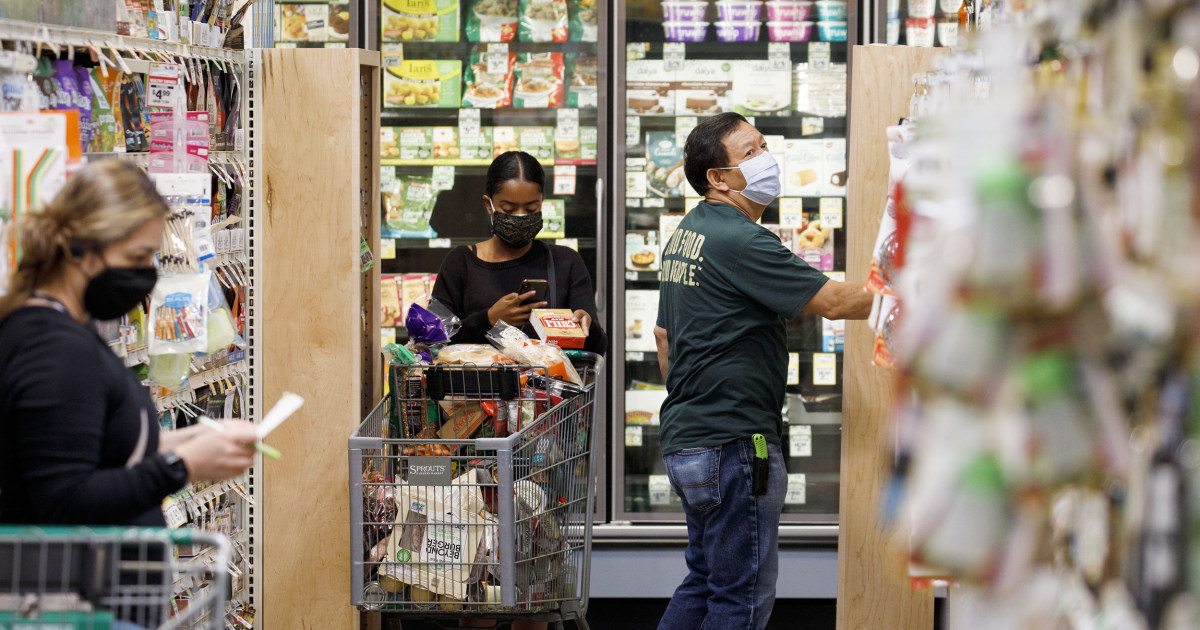
Shoppers had better start budgeting more for their grocery bills, according to the latest consumer price index, which shows prices are increasing — and they’re likely to keep going up.
The monthly consumer price index, released Tuesday morning by the Bureau of Labor Statistics, showed a 0.6 percent increase in March, the largest one-month increase in nearly a decade. Over the past year, prices have increased 2.6 percent overall.
Gas skyrocketed up 9.1 percent last month. Since February, fruits and vegetables have risen nearly 2 percent and the index for meats, poultry, fish and eggs have risen 0.4 percent, according to the government figures.
The latest spike in grocery bills comes on the back of prices that had already risen during last year’s pandemic stockpiling and supply chain disruptions and never went down. Consumers are noticing their inflating receipts.
Outside a Long Island, New York, supermarket, shopper John Kermaj said he’s seen prices rising in just the past two months.
“We used to buy this stuff for $30. Now it’s $60,” he said.
He has tried to adapt when shopping for his family by only buying essential items and avoiding name brands, but that also means skipping meat and fresh fish.
“Gotta be the pandemic,” Kermaj said. “Shortage.”
For more on this story, watch NBC Nightly News with Lester Holt at 6:30pm ET.
Before the pandemic began, the national average for a pound of bacon in January 2020 was $4.72. By last month, that price had soared to $5.11, according to exclusive supermarket point of sale data from Nielsen IQ. Ground beef is up $5.26 a pound from $5.02. Bread is up $2.66 a loaf from $2.44.
The hikes are more acute in certain areas of the country. Boston and Philadelphia are paying nearly a dollar more per pound of bacon, while Chicago is up about 70 cents. Dallas is seeing hikes of over 5 percent across several items at once, including eggs, chicken breast, fresh ground beef and sandwich bread.
Changes at the checkout are also pressuring grocery profit margins. Manufacturers have cut back on promotions and coupons to moderate demand ever since the stock-up period in March last year.
“In a typical month, 31.5 percent of units are sold on promotion; in the most recent period of March, 28.6 percent of units were sold on promotion,” said Phil Tedesco, vice president for Retail Intelligent Analytics at Nielsen, in an email. “This has led to shoppers having fewer opportunities to take advantage of sales in the store,” increasing total costs, he said.
Economists say costs from rising gas prices, a spike in commodity prices, increased imports by China, heavy midwest crop damage, and other factors are all getting passed on to retail consumers.
“Supply chains are largely inefficient at this time,” said Isaac Olvera, agricultural economist for ArrowStream, a supply chain management software company. “We’re still dealing with fallout from the pandemic.”
Issues like higher gas prices, increasing transport costs that get passed on to consumers, especially for items like bread, are only going up as driving increases faster than oil production. So grocery prices are likely to remain on the higher end of estimates for at least the rest of the year, Olvera said. Producers may eventually increase their output in order to capture the heightened demand, but that won’t happen until toward the end of this year, Olvera said.
The White House said Monday that it expects inflation to go up — and not go back down.
Three temporary factors are driving the increase, Jared Bernstein and Ernie Tedeschi, members of President Joe Biden’s Council of Economic Advisers, wrote in a blog post: The rate of increase looks faster when it rises from a lower level, supply chain disruptions and pent-up demand for services.
“We think the likeliest outlook over the next several months is for inflation to rise modestly…and to fade back to a lower pace thereafter as actual inflation begins to run more in line with longer-run expectations,” they wrote, increasing from “historically low to more normal levels.”
The price increases have the potential to stoke food insecurity at a time when more than 9 million people are still out of work. The pennies can add up, week by week, family by family.
“Food is a necessity,” said Jayson Lusk, a Purdue University agricultural economist. “Lower income households spend a larger share of their income on food. When we see food prices increase, it affects lower income households more.”
Budget-conscious shoppers can try out some perennially true advice for reducing their bills, with a couple of digital twists, said Amy Keating, a registered dietician for Consumer Reports, a nonprofit consumer watchdog and publisher.
Keating recommends signing up for a coupon aggregator app like Flipp, or a price-comparison app like Basket, which also includes online prices. Take pictures of items with their prices to help remember what the average prices are, especially for costlier items like olive oil and nuts. And if the price sticker doesn’t show unit price, use your phone’s calculator.
Classic advice still works, like shopping only based on a list to avoid impulse buys, going for store or generic brands if they’re less expensive, and swapping pricier meats for cheaper cuts, or downsizing to chicken or beans.
“We need to be a little bit more flexible if some of our favorites have become expensive,” Keating said.
Outside the Long Island supermarket, shopper Joanne Budhu said her family is adjusting their meals based on what they can afford in the store.
“We’re not big meat eaters in our family,” Budhu said, but noted that dairy prices have gone up.
“So we try to cut back,” she said. “We try to go in different recipes and… substitute, and not to cook that much stuff that would [be] expensive.”
Source: | This article originally belongs to Nbcnews.com










